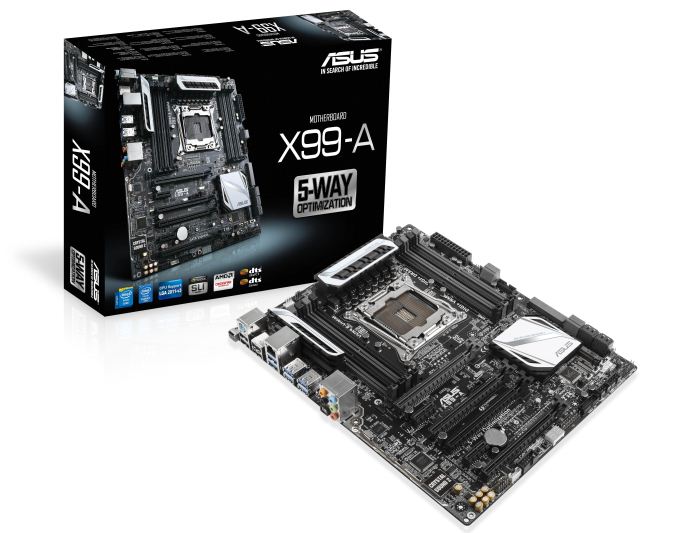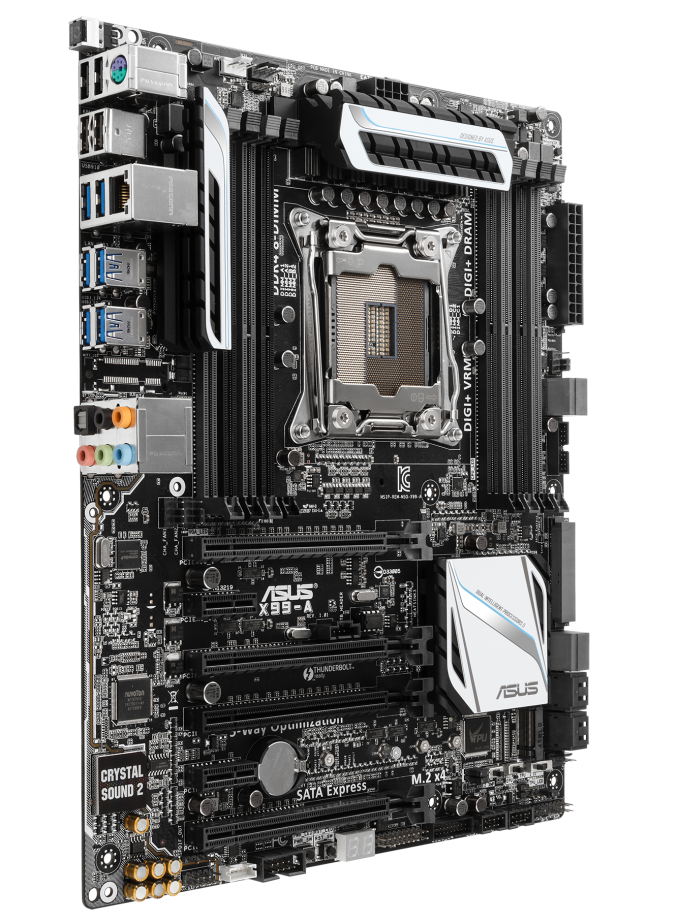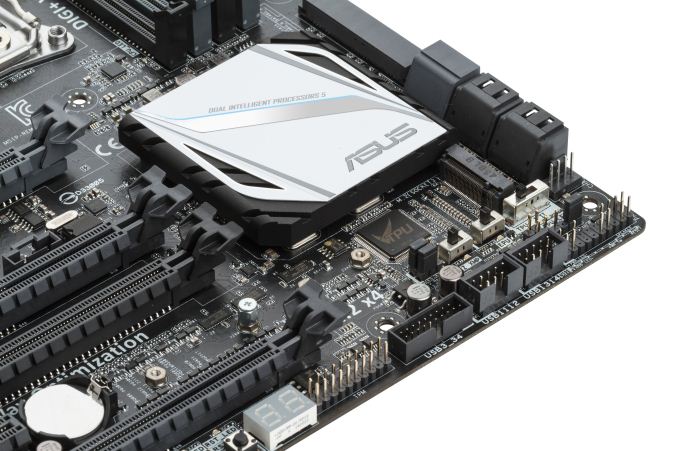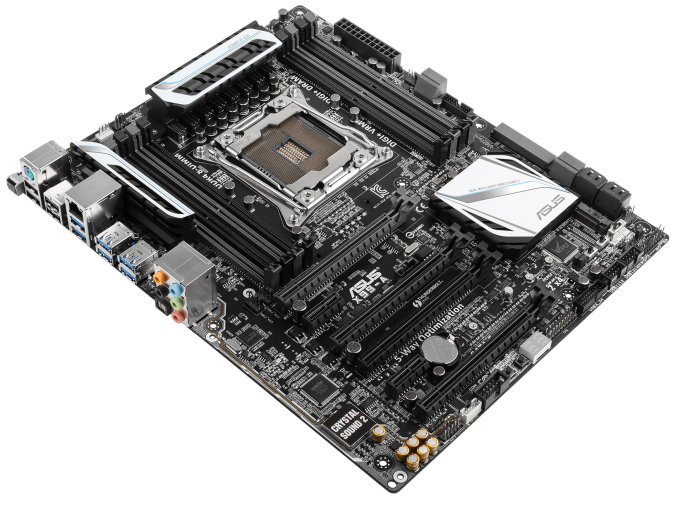ASUS X99-A Motherboard Review
by Ian Cutress on December 22, 2014 2:00 PM EST- Posted in
- Motherboards
- Intel
- Asus
- Haswell-E
- LGA2011-3

X99 and Haswell-E, due to the price, the performance and the feature set, ends up being very expensive compared to the mainstream. It is an odd state of affairs in the self-build arena when a reviewer states that the budget end of a spectrum is sub-$300. In this space we find the ASUS X99-A at $275 MSRP. This motherboard is the topic of our review today.
When considering the motherboard market as a whole, in all except in the server market, the $300 level usually represents the premium level marker. There are very few motherboards on the Z97 chipset that pass this barrier for example, and those that do are usually the cream of the crop. As a result, with Z97 the $250-$300+ range really aims for the higher mainstream performance and functionality. In X99, the $250-$300 level is the base. One of the reasons for this is that due to the prosumer nature of the market, where every motherboard has a lot of features which do not come cheap. There's very little demand for a stripped system outside of the OEM market.
So as a result, the budget end of the market for X99 is still feature packed, even with the X99-A. For comparison we reviewed the $400 ASUS X99-Deluxe when the chipset first launched, and it came with almost everything apart from the kitchen sink. The Deluxe was ASUS' main product for the X99 launch focus, and the X99-A arrived a few weeks later. At $275 it represents a cut down version of the Deluxe.
ASUS X99-A Overview
One new feature that crosses over from the Deluxe is the EZ XMP switch on the board, allowing users to apply their high speed memory profile without even touching the BIOS. My last trip to a LAN event resulted in anecdotal findings of high speed memory kits being used at JEDEC speeds, so something as simple as this should help let users get the most out of their memory.
For gaming or PCIe coprocessor use, this board is aimed at tri-GPU setups with a full PCIe 3.0 x16/x16/x8 layout. One potential benefit of this rather over focusing on full-bandwidth four-way arrangements is that the three-way version saves some build cost by avoiding the additional timing circuits needed for full bandwidth when using four cards. There is an additional PCIe 2.0 x4 slot from the PCH in the middle of the main PCIe slots for Thunderbolt or additional cards. This is situated as to not interfere with dual slot PCIe configurations.
As with most X99 boards there is full access to the 10 SATA ports from the PCH - six of which are RAID capable and the other four which are not as they are from the secondary AHCI controller. For good measure there is also a SATA Express port and a M.2 x4 Gen 3.0 port, with the SATA Express getting RST privileges. The SATA Express shares bandwidth with the PCIe 2.0 x4 slot whereas the M.2 is switched with the final PCIe slot. There are 10 USB 3.0 ports total which come as five from the PCH (two headers and a rear IO port), three from an ASMedia hub (rear panel) and two from an ASMedia controller (also rear panel). An interesting deviation in design is that the ASMedia ASM1074 hub used on the board is a 1-to-4 hub but only three ports are used. This is most likely due to the rear panel design, where a set of three USB ports doesn't really exist.
In terms of performance the system does not implement Multicore Turbo, meaning that stock performance is down compared to some other products but a simple click on the TPU switch avoids this with a small 3.9 GHz overclock. ASUS' strengths on X99 remain the audio performance, with the POST times and power consumption being ballpark for the chipset. ASUS also bundles in their BIOS and software combination which both hit the higher notes in terms of the competitors.
At the time I started writing this review the ASUS X99-A was only $240 at Newegg, making it a really nice price, however it has since gone back up to $275. The other X99 motherboard from this price range we have reviewed scored quite highly and the X99-A gives it a run for its money for sure.
Visual Inspection
Part of the initial appeal of the X99-Deluxe was the style in which it was presented – the white and silver livery gave it a streamlined look, and the protective cover over the rear IO and audio section of the motherboard added to that effect. The X99-A retains some of this styling, although it is limited in effect due to it only being on the three heatsinks. These heatsinks are also not joined to each other, which might reduce the effect of the aesthetic.
Nevertheless the motherboard itself feels a little busy, with lots of components having the white border around them for the SMT machines for placement. The socket area is fairly busy in that regard, and the CPU has access to five of the fan headers – two 4-pin CPU headers in the top right, two chassis headers to the bottom left of the DRAM slots near the rear panel, and another just below the 24-pin ATX header. The final fan header is below the SATA ports, with a FAN_EXT header for fan extension cards on the bottom of the board near the rear audio port. Each of these fans is 4-pin and can support PWM and DC fans.
Alongside the DRAM on the right hand side is the MemOK button, useful for recovering from failed POST due to memory issues. Beneath this is the 24-pin power connector and a fan header, followed by two of the SATA ports. These are RAID/RST compatible, along with the next four in grey, but the following four in black are not as they are from the secondary AHCI controller on the chipset. The middle two grey SATA ports are part of the SATA Express connector, and between all of these is one of the USB 3.0 headers.
In the chipset area of the board, below the heatsink is the M.2 x4 Gen 3.0 slot, supporting 2242 to 22110 sized drives. Underneath is our EZ XMP switch, EPU and two-stage TPU.
Along the bottom of the board, from right to left, is the front panel header, two USB 2.0 headers, a USB 3.0 header, a TPM header, the two-digit debug LED, power and reset buttons, a COM header, the fan extension header and the front panel audio.
The Crystal Sound 2 audio solution is an upgraded ALC1150 configuration featuring PCB separation, an EMI shield and filter caps for the front panel audio. Also in this area the PCIe arrangement gives a PCIe 3.0 x16, 2.0 x1, 2.0 x4, 3.0 x16, 2.0 x1 and a 3.0 x8. This gives x16/x16/x8 for GPUs when a 40-lane PCIe CPU is used, or x16/x8/x4 when a 28-lane CPU is used. Unfortunately that means that the i7-5820K will not be able to use three-way SLI. Also worth noting is that when the M.2 slot is in use, the final PCIe slot is disabled due to bandwidth switching.
The rear panel gives the USB BIOS Flashback button, a combination PS/2 port, four USB 2.0 ports, an Intel I218-V network port, six USB 3.0 ports and the audio jacks. The six USB ports are split such that those under the network port are from the controller, the next two to the right are from the hub, and the final two are split between one from the PCH and one from the hub.
Board Features
| ASUS X99-A | |
| Price | US (Newegg) |
| Size | ATX (305 x 244 mm) |
| CPU Interface | LGA2011-3 |
| Chipset | Intel X99 |
| Memory Slots | Eight DDR4 DIMM slots supporting up to 64 GB Up to Quad Channel, 2133-3200 MHz |
| Video Outputs | None |
| Network Connectivity | Intel I218-V |
| Onboard Audio | Realtek ALC1150 via Crystal Sound 2 |
| Expansion Slots | 2 x PCIe 3.0 x16 1 x PCIe 3.0 x8 1 x PCIe 2.0 x4 (default x1) 2 x PCIe 2.0 x1 |
| Onboard Storage | 6 x SATA 6 Gbps, RAID 0/1/5/10 4 x S_SATA 6 Gbps, no RAID 1 x SATA Express 1 x M.2 x4 Gen 3 for 2242 to 22110 |
| USB 3.0 | 2 x Headers for 4 Ports (PCH) 1 x Rear Panel Port (PCH) 2 x Rear Panel Ports (ASMedia controller) 3 x Rear Panel Ports (ASMedia hub) |
| Onboard | 10 x SATA 6 Gbps Ports 1 x SATA Express 1 x M.2 x4 Gen 3 6 x Fan Headers 2 x USB 3.0 Headers (PCH) 2 x USB 2.0 Headers Thunderbolt Header COM Header TPM Header EZ XMP Switch DirectKey Header MemOK Button Thermal Sensor Header TPU/EPU Switches Power/Reset Puttons Overvolt Header EXT_Fan Header SLI/CFX Switch Front Panel Header Front Audio Header |
| Power Connectors | 1 x 24-pin ATX 1 x 8-pin CPU |
| Fan Headers | 1 x CPU (4-pin) 1 x CPU_OPT (4-pin) 4 x CHA (4-pin) |
| IO Panel | USB BIOS Flashback Button Combination PS/2 Port Four USB 2.0 Ports Five USB 3.0 Ports via ASMedia One USB 3.0 Port via PCH Intel I218-V Network Port Audio Jacks via Realtek ALC1150 |
| Warranty Period | 3 Years |
| Product Page | Link |






















37 Comments
View All Comments
DanNeely - Tuesday, December 23, 2014 - link
No. Look at the pictures; 6 blue (3.0) and 4 black (2.0) USB ports.Until Intel goes all USB3 on it chipset, most boards with many ports are either going to do a mix of both types, fake it with hub chips, or both. And since the Skylake Leaks indicate we'll probably still be mixed USB (or hub) on higher end boards (midrange will probably be able to go all 3.0); it's probably going to be 2017 until USB3.x becomes ubiquitous.
kenshinco - Tuesday, December 23, 2014 - link
You said this board doesn't implement Multicore Turbo but its specs does says Intel Turbo boost supported. Could you elaborate more on this.Does this means it will get turbo boosted for single core only? 8 cores active can not get turbo boosted?
SuperVeloce - Wednesday, December 24, 2014 - link
This most likely means turbo boost is behaving as Intel said it should, more cores active, lower the frequency (for 5960x and all cores its usually 3-3.2ghz). Multicore turbo usually gets you highest turbo frequency for all cores (so it would leave it 3.5ghz@16threads if temperatures allow it).dcoca - Friday, January 9, 2015 - link
I have this board and Multicore is there in the bios with the opt for all cores or per core...EricCC - Wednesday, December 24, 2014 - link
Great article. I was ready to buy one until I saw the post times. 20+ seconds is horrible. My two year old Surface and one year laptop with Haswell post in 2-3 seconds and their CPUs are much slower. And my 5+ year old system is twice as fast posting.I thought EFI BIOS were supposed to be significantly faster and I expected newer machines to be faster. Have manufacturers explained the severe slowness?
Are these new motherboards any faster with Windows 8?
EricCC - Wednesday, December 24, 2014 - link
i should have said, any faster POSTING with Windows 8?DanNeely - Wednesday, December 24, 2014 - link
POST is the time spend *before* the boot loader starts your OS. In general, the more stuff that needs to be started up, the longer it will take to POST; however, I suspect that an additional factor vs Z97 boards which post in half the time is that more effort has been put into optimizing performance for the mass market product than for something that's mostly used in servers/etc where it's a much less important factor.EricCC - Thursday, December 25, 2014 - link
I am aware that POST time is pre-OS, and all the times I stated are POST only. The OS loads in around 10 seconds so most of my systems boot faster than the X99 motherboards POST. Do you think these boards would POST faster with Windows 8? I thought systems that were Windows 8 aware were able to skip part of POST or at least do something differently.I also agree that POST and boot times in servers tends not to be that important but I don't think these boards are for servers, which don't need the ability to run with multiple graphics cards or to overclock.
Do you not think that 20+ second POST times are extremely long for computers nowadays?
DanNeely - Thursday, December 25, 2014 - link
No. Your OS has nothing, and can have nothing, to do with POST time because your OS doesn't get involved until the POST is complete. It doesn't matter if you're running Windows 8. or Windows 7, or Windows 3.11, or Linux, or BSD, or BeOS.What Win8 does is to only partially shutdown by default when you turn it off. It closes down everything in userspace and then hibernates the kernel. Then when you power on, after the computer POSTs, and after the boot loader starts win8, win8 just unhibernates the kernel and restarts userland; which is faster than starting the OS from scratch. This also only helps if you're someone who turns his computer off on a regular basis instead of just leaving it up until the next patch tuesday; because in that case the patches require restarting the kernel.
These boards aren't going into servers; but 99% of consumer boards are LGA1150; which is where the OEMs put their effort. LGA2011 is an entry level server product; and 99% of the chipsets for them go into servers where it doesn't matter.
X99 is too small a market to justify any sort of performance tuning; the boards are already a lot more expensive than z97 because the tiny number of boards that are sold means there's not much to spread the engineering costs for the board layout over. If you wanted to lift the base price of the boards another $100+ each it might be possible to optimize the startup times down to the same 10s ballpark of z97. You'll probably never see desktop boards get down to the 1-3s range of thin laptops/tablets because the latter have so much less stuff to enable, and everything that they need to turn on and since everything is soldiered and non-replacable they can encode all the settings into the firmware instead of having to detect the components and determine how to configure them every time they're powered on.
ziphnor - Friday, December 26, 2014 - link
The X99-A BIOS is full of options that allow faster POST (like not looking for other drives than the boot drive etc). So it can probably be tweaked.